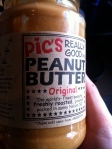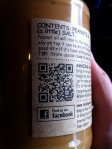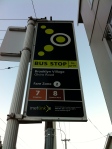As I wonder around Wellington lately I started to realise how much Web 2.0+ (2.5, 3.0) concepts and technologies I actually interact with on a day to day basis.
After looking into some of the more formal definitions of these evolutions of the web, 2.0 with the web being used as a platform for social interaction, 2.5 with its “mobile” application of 2.0 ideas and 3.0 looking at being the “semantic” web (web that understands what we are trying to find by providing extra data about our context or preferences).
Here is a few of the more interesting situations and examples that are not the usual Facebook checking or Twitter tweeting.
Breakfast (Pic’s Really Good Peanut Butter)
Ok, so I enjoy breakfast, nothing like a nice hot coffee fresh off the stove-top peculator and some delicious peanut butter on toast… but this particular peanut butter is no ordinary peanut butter. This is Pic’s Really Good Peanut butter made in Nelson and has a great story behind it. What caught my attention one morning while I was about to smear my toast with this peanut butter 2.0 goodness was the QR code directly to their Facebook page right there on the side of the jar. Being the always connected person with a smart phone in my pocket I snapped the QR code, got taken to their Facebook Page and was able to “like” it and start having a conversation with the makers of this fine breakfast spread. A quick read of some of the comments and posts from Pic’s and fans shows that they are indeed commited to holding a real conversation around their products and even are looking at testing out new versions of their products (a smooth variety of their peanut butter) with consumers to make sure they are delivering the right things to those who want them (on their toast). So while there are some technology enablers involved the real shift is in the social interactions and willingness of businesses to be a bit more human in their dealings.
Coffee Break (Cafe Carbie and Reward Junkie)
For those of you with a caffine addiction this next example is for you. My local coffee shop, Cafe Carbie are again one of those great businesses with a great story (is there a trend appearing here?) they seem to “get” and embrace using Social Media (such as their Facebook Page). However, the technolgoy I want to highlight here is a third party smart phone application and service called Reward Junkie that the cafe uses. Reward Junkie is utilising the web as its platform in providing a geo-location based, loyalty card style service directly on a customers smart phone which they “snap” a QR code in-store to gain reward points. Let’s face it, we only have so much room in our wallets for these type of cards but leveraging the web to store this data and interacting with it through a device that a lot of us carry makes a lot of sense. It builds loyalty for the businesses and over time the data collected about customers, demographics and how frequently they visit will be able to play into the idea of the semantic web as mentioned earlier, this type of data helps businesses make more empirical and smarter business decisions.
Getting Around (MetLink Wellington)
My last example is another use of mobile and geo-location based technology to help us get around the city via public transport. Again this service is based on using the web as a platform, so much so that the mobile application is based on web technology. If you visit MetLink’s website from a smart phone it will instantly direct you to a mobile optimised web experience and ask if you would like to use the location services on the phone, no need to download a separate application. I think this really demonstrates the idea that there is no clear cut divider among the 2.0 – 3.0 phases of web evolution in terms of the technology, in this case it is a combinations of good old URI, HTTP request, extra data from the location service on the phone all delivered through the web platform to a mobile device.
I can then simply click one button to find a list of bus stops and times for those near my geographic location or I can interact with the application and enter the bus stop number to get the exact time of departure of the next bus. There are even some stops in the CBD that are using the QR codes as on the Pic’s Peanut Butter jar which makes this process even easier. I make a point of using the QR code when I’m out and about to show others around me how easy it is to use and interact with something that augments your experience in the real world. I just hope someone at MetLink is tracking the use of those QR codes through Web Analytics to build a case for demand/use and to help them drive a decision to deploy them elsewhere. Later on perhaps they could even utilise RFID technology for the same purpose.
This is just a small sampling of some of the Web 2.0 – 3.0 ideas and technologies out there in the wild that I seem to interact with on a daily basis (that is if I have peanut butter toast everyday!)
What are some of your examples?






 I think that some of the reason behind all the misconceptions of what “Web 2.0” is from a businesses adoption point of view comes from this: the technologies and interaction is the most visible part of this paradigm shift and so this is what people wanting to adopt “Web 2.0” see and then think that it is… the whizbang, the design and asthetic of it rather than the social change.
I think that some of the reason behind all the misconceptions of what “Web 2.0” is from a businesses adoption point of view comes from this: the technologies and interaction is the most visible part of this paradigm shift and so this is what people wanting to adopt “Web 2.0” see and then think that it is… the whizbang, the design and asthetic of it rather than the social change.

